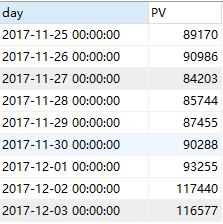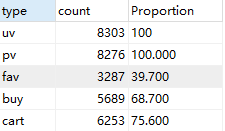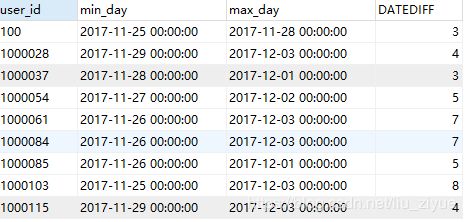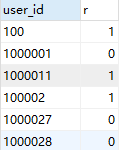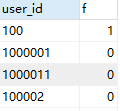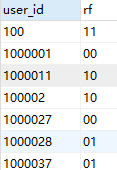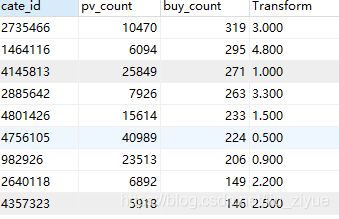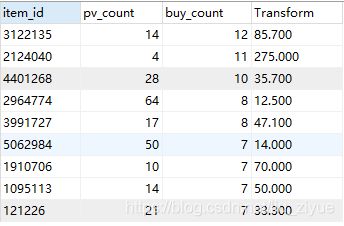用户行为分析(SQL)
一、前言
之前在博客记录了一篇行为分析(python)的文章,后来觉得自己可以用SQL再走一遍,也算练练手。数据来源于天池的2020-04-13的“UserBehavior.csv”。
数据集包含了2017年11月25日至2017年12月3日之间,有行为的约一百万随机用户的所有行为(行为包括点击、购买、加购、喜欢)。数据集的组织形式和MovieLens-20M类似,即数据集的每一行表示一条用户行为,由用户ID、商品ID、商品类目ID、行为类型和时间戳组成,并以逗号分隔。
我自己的MySql版本是5.5,Navicat是10.1,窗口函数不支持。另外,这一次我并没有将表拆分,之后的处理和查询也都是在一表中进行的,工作中还是应该循序范式操作。
以下是我的分析操作流程,这里就不再做过多的结论描述了,毕竟只是对前文各分析模块用Sql取数。
二、分析流程
依然从以下四个方向着手进行分析
1.1 用户行为时间模型
PV、UV。
留存率。
1.2 用户消费行为分析
各周期内消费次数统计。
各行为转化模型。
复购率。
回购率。
1.3 用户价值分析
RFM模型。
1.4 商品分析
商品和行为关系。
TOP商品分析。
三、数据处理
源数据中的时间是时间戳,这里我将时间戳进行转换,并且增加日期和对应时段用于后续分析,因为电脑配置原因,我这里只写入大概80万条数据,实在是卡的要命。。。
1.新增列
增加转化后的数据date(%Y-%m-%d %H:%i:%s)
alter table ub add date VARCHAR(32)
UPDATE ub SET date = FROM_UNIXTIME(time,'%Y-%m-%d %H:%i:%s')
SELECT * from ub limit 10
新增日期(%Y-%m-%d)一列
alter table ub add day VARCHAR(32)
UPDATE ub SET day = cast(date as DATE)
新增小时列
alter table ub add hour VARCHAR(32)
UPDATE ub SET hour = right(CONVERT(date,TIME),8)
UPDATE ub SET hour = hour(date)
alter table ub modify column date datetime
alter table ub modify column day datetime
alter table ub modify column hour INT
2.查看缺失值
SELECT COUNT(1) FROM ub WHERE user_id IS NULL
3.备份表
有备无患
SELECT * INTO behavior_ORIG FROM behavior
4.删除无关日期
因为实际数据中不仅仅是2017-11-25 到 2017-12-04的数据,也有一些零零碎碎的杂项,所以对无关日期进行了删除处理。
DELETE FROM ub WHERE day < '2017-11-25' OR day >= '2017-12-04'
三、各分析项数据提取
1.用户行为时间模型
1.1每日pv
SELECT
day,
COUNT(1) PV
FROM ub
GROUP BY day
ORDER BY day ASC
1.2时段pv
SELECT hour,count(1)
from ub
GROUP BY hour
ORDER BY hour asc
1.3留存
SELECT
diff_day.min_day as min_day,
sum(case when diff_day.to_fday=0 then 1 else 0 end) as day_1,
sum(case when diff_day.to_fday=1 then 1 else 0 end) as day_2,
sum(case when diff_day.to_fday=2 then 1 else 0 end) as day_3,
sum(case when diff_day.to_fday=3 then 1 else 0 end) as day_4,
sum(case when diff_day.to_fday=4 then 1 else 0 end) as day_5,
sum(case when diff_day.to_fday=5 then 1 else 0 end) as day_6,
sum(case when diff_day.to_fday=6 then 1 else 0 end) as day_7,
sum(case when diff_day.to_fday=7 then 1 else 0 end) as day_8
from
(SELECT a.user_id,a.day,b.min_day,DATEDIFF(a.day,b.min_day) as to_fday
from ub as a
LEFT JOIN
(SELECT user_id, min(day) as min_day
from ub
GROUP BY user_id) as b
on a.user_id=b.user_id
order by a.user_id,a.day) as diff_day
GROUP BY diff_day.min_day
ORDER BY diff_day.min_day
2.用户消费行为分析
2.1各类行为随日期的变化
SELECT
gp_day_type.type,
max(case when gp_day_type.day = '2017-11-25 00:00:00' then gp_day_type.type_count ELSE 0 end) as '2017-11-25',
max(case when gp_day_type.day = '2017-11-26 00:00:00' then gp_day_type.type_count ELSE 0 end) as '2017-11-26',
max(case when gp_day_type.day = '2017-11-27 00:00:00' then gp_day_type.type_count ELSE 0 end) as '2017-11-27',
max(case when gp_day_type.day = '2017-11-28 00:00:00' then gp_day_type.type_count ELSE 0 end) as '2017-11-28',
max(case when gp_day_type.day = '2017-11-29 00:00:00' then gp_day_type.type_count ELSE 0 end) as '2017-11-29',
max(case when gp_day_type.day = '2017-11-30 00:00:00' then gp_day_type.type_count ELSE 0 end) as '2017-11-30',
max(case when gp_day_type.day = '2017-12-01 00:00:00' then gp_day_type.type_count ELSE 0 end) as '2017-12-01',
max(case when gp_day_type.day = '2017-12-02 00:00:00' then gp_day_type.type_count ELSE 0 end) as '2017-12-02',
max(case when gp_day_type.day = '2017-12-03 00:00:00' then gp_day_type.type_count ELSE 0 end) as '2017-12-03',
max(case when gp_day_type.day = '2017-12-04 00:00:00' then gp_day_type.type_count ELSE 0 end) as '2017-12-04',
max(case when gp_day_type.day = '2017-12-05 00:00:00' then gp_day_type.type_count ELSE 0 end) as '2017-12-05',
max(case when gp_day_type.day = '2017-12-06 00:00:00' then gp_day_type.type_count ELSE 0 end) as '2017-12-06'
from
(SELECT day, type, count(user_id) as type_count
from ub
GROUP BY day, type) as gp_day_type
GROUP BY gp_day_type.type
2.2行为转化
SELECT
type,
count(user_id) as count,
round((count(user_id)/(SELECT count(user_id) from ub where type='pv')),3)*100 as 'Proportion'
from ub
GROUP BY type
ORDER BY Proportion asc
2.3UV转化率
刚看到我这里用了a.*,实际中应该避免这样写法
SELECT a.*
from
(SELECT
type,
count(DISTINCT user_id) as count,
round((count(DISTINCT user_id)/(SELECT count(DISTINCT user_id) from ub where type='pv')),3)*100 as 'Proportion'
from ub
GROUP BY type
UNION all
SELECT
'uv' type,
count(DISTINCT user_id) as count,
'100' as 'Proportion'
FROM ub) as a
ORDER BY a.Proportion asc
2.4复购率
这里我用有复购行为的用户数 / 有购买行为的用户数
SELECT
((select
sum(buy_s.count)
from
(SELECT
user_id,
count(user_id) as count
from ub
where type='buy'
group by user_id
having count(user_id)>2) as buy_s)
/
(select
sum(buy_o.count)
from
(SELECT
user_id,
count(user_id) as count
from ub
where type='buy'
group by user_id) as buy_o))*100 as '复购率'
2.5复购间隔天数分布
SELECT
gp_days.user_id,
min(gp_days.day) as min_day,
max(gp_days.day) as max_day,
DATEDIFF(max(gp_days.day),min(gp_days.day)) as DATEDIFF
FROM
(SELECT
buy_all.user_id,buy_all.day
from
(SELECT user_id, day
from ub
where type='buy') as buy_all
join
(SELECT user_id, count(user_id) as count
from ub
where type='buy'
group by user_id
having count(user_id)>2) as buy_s
on buy_all.user_id=buy_s.user_id) as gp_days
GROUP BY gp_days.user_id
3.用户价值分析(RFM模型)
这里我的思路是取出各用户的最近一次消费时间、消费频率、共计消费金额,之后分别计算这三类的平均值,最后再用三类数据减去均值,如果大于0置1,小于0置0。
源数据中没有消费金额项,所以只能将用户分成四类
3.1 -R 最近一次消费时间
3.1.1 r平均值
SELECT
avg(a.datediff)
FROM
(SELECT user_id,
datediff('2017-12-03 00:00:00',max(day)) as datediff
from ub
where type='buy'
GROUP BY user_id) as a
3.1.2所有数据最大日期
SELECT max(day) from ub
3.1.3R列
SELECT user_id,
if(datediff('2017-12-03 00:00:00',max(day))-2.5076>0,1,0 ) as r
from ub
where type='buy'
GROUP BY user_id
3.2 -f 消费频率
3.2.1平均消费频率
SELECT
avg(a.count)
FROM
(select user_id,count(1) as count
from ub
where type = 'buy'
GROUP BY user_id) as a
3.2.2 F列
select user_id,
if(count(1)-3.0346 >0 ,1, 0) as f
from ub
where type = 'buy'
GROUP BY user_id
4 RF模型
SELECT
r.user_id,CONCAT(r.r,f.f) as rf
FROM
(SELECT user_id,
if(datediff('2017-12-03 00:00:00',max(day))-2.5076>0,1,0 ) as r
from ub
where type='buy'
GROUP BY user_id) as r
join
(select user_id,
if(count(1)-3.0346 >0 ,1, 0) as f
from ub
where type = 'buy'
GROUP BY user_id) as f
ON r.user_id=f.user_id
4. 商品分析
4.1 前十类目点击量和购买量关系分析desc
SELECT buy.cate_id,pv.pv_count,buy.buy_count,round(buy.buy_count/pv.pv_count,3)*100 as Transform
from
(SELECT cate_id,count(1) as buy_count
from ub
where type='buy'
GROUP BY cate_id) as buy
join
(SELECT cate_id,count(1) as pv_count
from ub
where type='pv'
GROUP BY cate_id) as pv
on buy.cate_id = pv.cate_id
ORDER BY buy.buy_count desc
LIMIT 10
4.2 前十商品点击量和购买量关系分析desc
SELECT buy.item_id,pv.pv_count,buy.buy_count,round(buy.buy_count/pv.pv_count,3)*100 as Transform
from
(SELECT item_id,count(1) as buy_count
from ub
where type='buy'
GROUP BY item_id) as buy
join
(SELECT item_id,count(1) as pv_count
from ub
where type='pv'
GROUP BY item_id) as pv
on buy.item_id = pv.item_id
ORDER BY buy.buy_count desc
LIMIT 10
